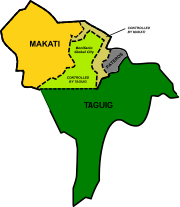After the destruction Second World War had brought upon Makati, and the subsequent closure of Nielson Field, the town grew rapidly, and real estate values boomed. The first of the planned communities (in what are now the barangays Forbes Park, Urdaneta, San Lorenzo and Bel-Air) were established in the 1950s with the efforts of its landowner, Ayala y Compañía. At the same time, Fort McKinley, then renamed Fort Bonifacio, and the then Philippine Army headquarters, became the starting point for the building up of seven more communities by military families who worked in the base area. The first office buildings were built on what is now the Makati Central Business District. Since the late 1960s, Makati has transformed into the financial and commercial capital of the country.[10]
During the terms of town mayors Máximo Estrella, Rafael Bañola, José Luciano, Cézar Alzona and Nemesio Yabut, massive development of the town took place, and foreign and local investors were welcomed to what was tagged as the nation's number one municipality at the time. Makati's central location adjacent to the city of Manila also made it an industrial hub for major national and international corporations. Partly as a result a new town hall just miles from the old one was built in 1962 just along J.P. Rizal Avenue (the old hall was later converted into the city museum). Mayor Bañola's term of office as town executive saw the building up of what is now the Ayala Center with the help of the Ayala firm, which would become the city's central shopping center of today.
In 1975, Makati was separated from Rizal province along with Caloocan, Malabon, Navotas, Quezon City, Marikina, San Juan, Pasig, Mandaluyong, Pateros, Taguig, Pasay City,Parañaque, Las Piñas, and Muntinlupa, to become part of the National Capital Region as a component municipality.
Following the assassination of opposition senator Benigno Aquino, Jr. on 21 August 1983, Makati became a nexus for protests against the dictatorship of President Ferdinand E. Marcos. Known as the Confetti Revolution, the demonstrations held in the central business district were led partly by employees of major corporations based in the area, culminating in the 1986 People Power Revolution that toppled Marcos’ 20-year authoritarian regime. His political rival and successor, Corazon C. Aquino–the wife of the deceased senator Aquino–became the eleventh and first female president of the Philippines. After the death of Mayor Yabut during the Revolution, Aquino appointed Jejomar Binay as acting mayor of the town of Makati; he was subsequently elected as mayor in 1988. His first term as the town executive would see the events of a 1989 coup d'etat attempt in the town's business district, and would help usher the building of the country's first skyscrapers in the early 1990s.
On May 17, 2000 at 5:02 p.m., the Glorietta Mall located inside the Ayala Center was bombed, injuring 13 persons. According to local authorities, the homemade bomb originated from a restroom of a restaurant a video arcade. The bombing was said to be the precursor of the May 21, 2000 SM Megamall bombing and the Rizal Day bombings.[13] On October 19, 2007, an explosion in Glorietta 2 left eleven people dead and injured more than a hundred. Initially, authorities said that it was caused by a liquefied petroleum gas explosion at a restaurant, but later began investigating the possibility that the explosion may have been a C-4 bomb.[14][15]
Geography[edit]
Makati is located within the circle of 14′40″ °north and 121′3″ °E right at the center of Metro Manila. The city is bounded on the north by thePasig River, facing Mandaluyong, on the northeast by Pasig, on the southeast by the municipality of Pateros and Taguig, on the northwest by the city of Manila, and on the southwest by Pasay. Makati has a total land area of 27.36 square kilometres (10.56 sq mi); it constitutes 4.3% of Metro Manila's total land area[citation needed].
Climate[edit]
Under the Köppen climate classification system, the city features a tropical monsoon climate. Together with the rest of the Philippines, Makati lies entirely within the tropics. Its proximity to the equator means that the temperature range is very small, rarely going lower than 20 °C (68 °F) or going higher than 38 °C (100 °F). However, humidity levels are usually very high which makes it feel much warmer. It has a distinct, albeit relatively short dry season from January through May, and a relatively lengthy wet season from June through December.
| [hide]Climate data for Makati, Philippines | |||||||||||||
|---|---|---|---|---|---|---|---|---|---|---|---|---|---|
| Month | Jan | Feb | Mar | Apr | May | Jun | Jul | Aug | Sep | Oct | Nov | Dec | Year |
| Average high °C (°F) | 30 (86) | 30 (86) | 31 (88) | 33 (91) | 34 (93) | 34 (93) | 33 (91) | 31 (88) | 31 (88) | 31 (88) | 31 (88) | 31 (88) | 31.7 (89.1) |
| Average low °C (°F) | 21 (70) | 21 (70) | 21 (70) | 22 (72) | 23 (73) | 24 (75) | 24 (75) | 24 (75) | 24 (75) | 24 (75) | 23 (73) | 22 (72) | 22.75 (72.95) |
| Average precipitation mm (inches) | 25.4 (1) | 25.4 (1) | 38.1 (1.5) | 25.4 (1) | 38.1 (1.5) | 127 (5) | 254 (10) | 431.8 (17) | 406.4 (16) | 355.6 (14) | 203.2 (8) | 152.4 (6) | 2,082.8 (82) |
| Source: makaticity.com[16] | |||||||||||||

No comments:
Post a Comment